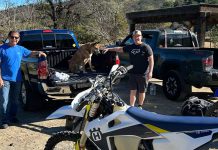This week in San Francisco, the California High-Speed Rail
Authority and the Federal Railway Administration publicly released
a draft environmental impact report for the project. This report
confirms the routes being considered for electrically powered
bullet trains that could get riders from San Francisco to Los
Angeles in two-and-a-half hours, reaching speeds of 220 mph.
This week in San Francisco, the California High-Speed Rail Authority and the Federal Railway Administration publicly released a draft environmental impact report for the project. This report confirms the routes being considered for electrically powered bullet trains that could get riders from San Francisco to Los Angeles in two-and-a-half hours, reaching speeds of 220 mph.
Rod Diridon, a High-Speed Rail Authority board member and the namesake of San Jose’s central train station, called the bullet train network “the strongest environmental effort I could think of for California.” It is both a way to slow air pollution from vehicle emissions and to contain sprawl by focusing growth on populated corridors, he said.
“We know the state of California is going to double in (population) by the year 2040,” Diridon said. “The best way in the world to (concentrate the population) is to build … train stations and build high-density development on top of that.”
Most of the route is set, but options exist for the passage between the Silicon and Central valleys, which a High-Speed Rail Authority fact sheet calls “one of the most difficult geographic encounters of the high-speed train system.”
If the train crosses at Pacheco Pass, it would stop twice between Fresno and San Jose: once in Los Banos and once in either Gilroy or Morgan Hill. Route designers originally listed Gilroy as the South Valley stop, but a new, alternate plan would bypass Gilroy – saving four miles of track – and stop in Morgan Hill instead. Both routes would have the bullet train use the Union Pacific/Caltrain tracks between the South Valley and San Jose.
Or, the electric train could bypass South Valley cities entirely and cut through the Diablo Range farther north, with no stops between Merced and San Jose. That could mean running under and through the northern part of Henry Coe – the second-largest of California’s state parks – or it could mean bypassing it to the north, through undeveloped private land between Coe Park and Mount Hamilton. There are two options for the Coe route: one with more tunneling and one with less.
Any of these northern passages would offer faster travel time between the Bay Area and the Sacramento-Stockton-Modesto corridor, according to planners, but they would require more tunneling than the Pacheco Pass options.
There very well could be no bullet train at all, since the cost to taxpayers to build it is now estimated at roughly $30 billion, according to Diridon.
Many critics, including former Gilroy Mayor Tom Springer, have taken sides against the high-speed rail project, saying the money would be better invested in highways and airports.
The Sierra Club, of which Diridon is a member, supports the idea of high-speed rail but has started a campaign against any route through Coe Park. Diridon vowed he would “do everything in my power to make sure that our rail system doesn’t go through any kind of park.”
The Sierra Club also has a negative outlook on the route that would bypass Coe Park to the north.
“It is just as devastating,” said Melissa Hippard, conservation representative with the Club’s Loma Prieta Chapter. This route would go through the San Antonio Valley, which Hippard described as a “pristine, natural ecosystem” and could deter possible Coe Park expansion to the north.
California voters may be asked in November to bond for several billion dollars – $9 billion was mentioned last summer as the likely amount – to pay for half of the route from the Bay Area to Los Angeles. The federal government, if Congress and the president approve, would contribute the other half. Diridon expects this route to cost $14 billion.
Extensions to Sacramento and San Diego would come later – completed by 2020, if everything stays on schedule.
Gov. Arnold Schwarzenegger has mentioned striking the November ballot measure, Diridon said, but the state Legislature may keep it.
Voters already will be deciding on a multi-billion-dollar bond in March to bail the state out of the deficit it is facing. If the bond doesn’t pass, the state could face budget cuts of historic proportions.
The bullet train’s EIR claims that high-speed rail will be the cheapest, cleanest, most energy efficient, safest and most reliable way for Californians to move between cities by the year 2020, when the population is expected to rise by 31 percent. By then, the report predicts, current roads and airways will be too crowded to accommodate transportation.
Expanding highways and airports to meet these demands would increase sprawl and air pollution and would ultimately be two to three times more expensive than the proposed 710-mile, high-speed rail network, the report claims.
State Assemblyman Simon Salinas (D-Salinas) said Monday he would support the November bond based on what he knows now about the bullet train project, but he would be open to changing his mind.
“Conceptually, I think this is something worth looking at,” Salinas said. “Certainly, if I heard that nobody likes it in my area, then I would change.”
Salinas said he also would rethink his support if multiple bond measures are proposed for November.
“I don’t think we should be crowding the November ballot with bonds,” Salinas said.
Next on the bullet train’s timetable is a series of public hearings.
Log onto www.cahighspeedrail.ca.gov for more information or to view the draft EIR.









